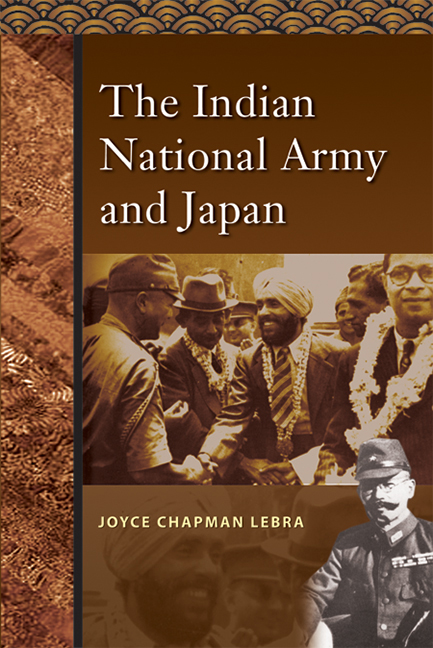Book contents
- Frontmatter
- Contents
- Illustrations and Maps
- Abstract
- Foreword
- Preface
- Acknowledgements
- Introduction
- 1 Mission to Bangkok
- 2 Malayan Jungle Meeting
- 3 Singapore Capitulates and the INA Blossoms
- 4 Tokyo Conference
- 5 Japanese Policy toward India
- 6 The Crisis of the First INA
- 7 Subhas Chandra Bose, Hitler, and Tōjō
- 8 Bose, the FIPG, and the Hikari Kikan
- 9 To India or Not?
- 10 The Rising Sun Unfurls; the Tiger Springs
- 11 A Plane Crash
- 12 A Trial in the Red Fort
- 13 Retrospect
- Notes
- Bibliographical Note
- Bibliography
- Index
- About the Author
- Frontmatter
- Contents
- Illustrations and Maps
- Abstract
- Foreword
- Preface
- Acknowledgements
- Introduction
- 1 Mission to Bangkok
- 2 Malayan Jungle Meeting
- 3 Singapore Capitulates and the INA Blossoms
- 4 Tokyo Conference
- 5 Japanese Policy toward India
- 6 The Crisis of the First INA
- 7 Subhas Chandra Bose, Hitler, and Tōjō
- 8 Bose, the FIPG, and the Hikari Kikan
- 9 To India or Not?
- 10 The Rising Sun Unfurls; the Tiger Springs
- 11 A Plane Crash
- 12 A Trial in the Red Fort
- 13 Retrospect
- Notes
- Bibliographical Note
- Bibliography
- Index
- About the Author
Summary
THE JAPANESE PERSPECTIVE
The Imphal campaign in India became the vortex of all the forces in the Indo-Japanese co-operation: the impact of the charismatic personality of Bose on IGHQ Tokyo, the problem of delineating Japan's policy aims toward India, Japan's logistics and military dilemma in Burma, differences over military protocol and command arising between the INA and the Japanese Army, and the Japanese attitude toward the INA and the Free India Provisional Government. The fate of Imphal determined the course of Japan's cooperation with the Indian independence movement in Southeast Asia. Imphal loomed large in the whole defence of Burma and the westward boundary of Japan's Greater East Asia Co-Prosperity Sphere. From the Japanese standpoint the military stakes at Imphal were critical. For the INA it was one real chance to break through the border and ignite the Indian revolution. At Imphal Japan and the INA at last cooperated in a military campaign, but with cataclysmic results.
The battle of Imphal was a major disaster in the military annals of the world and is still one of the most controversial Japanese campaigns of the entire Pacific War. A total of five Japanese generalsin- command and numerous staff officers were dismissed during and immediately following the action in an unprecedented attempt to fix blame for the fiasco. One staff officer in the supply section committed suicide; one general threatened to.
Japan's lightning dash through Thailand and Malaya had taken the British aback, especially with the successful capture of Singapore after a startlingly brief fight. When the Japanese Army overran Burma in 1942 there was a longer struggle, and the stakes were even higher. Burma in Japanese hands meant the severing of the all-important supply lines between China and India through which British and American support was funnelling to Chiang Kai-shek's forces. The only alternative to the legendary Burma Road from Mandalay through Lashio in Burma over the mountains to Kunming, China, was to airlift supplies from Indian airfields over the unmapped “Hump” into China. This was the mission of the swashbuckling Major-General Claire Chennault.
The end of 1942 saw the Axis everywhere successful. Rommel was in Egypt, the German invasion of Russia had gone smoothly. Nationalist China was on her knees, and India and Australia were expecting a Japanese invasion.
- Type
- Chapter
- Information
- The Indian National Army and Japan , pp. 149 - 173Publisher: ISEAS–Yusof Ishak InstitutePrint publication year: 2008



